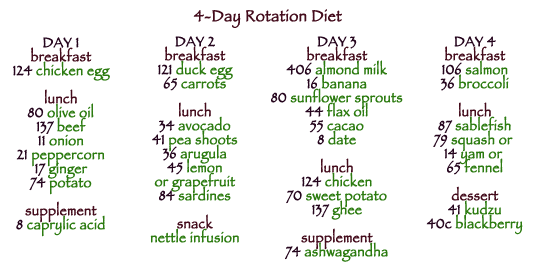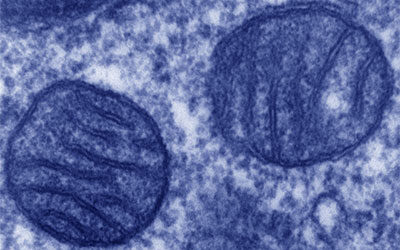 I know I should’ve done this YEARS ago…enough people have raved how a rotation diet has helped them overcome food intolerances and allergies. Over time, they were able to expand a very limited diet to include many foods they previously were unable to eat. It’s been used successfully by those with food allergies, autism, chemical sensitivity, chronic fatigue syndrome, and other chronic conditions that share digestive upset, allergies, or hyper-reactivity to environmental factors as a symptom – even when food does not seem to be the culprit, this diet can uncover hidden food allergies that could be the source of many of one’s symptoms.
I know I should’ve done this YEARS ago…enough people have raved how a rotation diet has helped them overcome food intolerances and allergies. Over time, they were able to expand a very limited diet to include many foods they previously were unable to eat. It’s been used successfully by those with food allergies, autism, chemical sensitivity, chronic fatigue syndrome, and other chronic conditions that share digestive upset, allergies, or hyper-reactivity to environmental factors as a symptom – even when food does not seem to be the culprit, this diet can uncover hidden food allergies that could be the source of many of one’s symptoms.
Given that I was burdened with extensive and severe food allergies almost overnight back in 1998 one month after exposure to toxic fumes in a fire, this should have been the first thing I did to recover my health. Unfortunately, it was years before I even heard of the diet, and even more years before I had the strength of mind and gut to put one together. I was too busy trying to manage the severe symptoms I was experiencing, finding foods I could eat safely, and completely overhauling my diet to a blend of Weston A. Price/Nourishing Traditions philosophy, raw living foods and Specific Carbohydrate Diet (SCD).
The basic premise behind a 4-day rotation diet is that it takes that long for food to pass through your system and so you want to avoid eating any one food more than once every four days, otherwise you will most likely sensitize to it. Foods are grouped into “food families” and you can eat from the same food family every other day. You can eat two foods from the same food family on a single day (within an hour) but you must not eat any other food from that family for another 4 days. If you can’t manage to do a 4-day rotation diet, you could try a 3-day rotation and once you acclimate to it, add in one more day of new foods.
The hardest part about a food rotation diet is planning it out. Once you know what foods you will eat each day, there is no thinking required! A few years back, I purchased the Rotational Bon Appetit Cookbook from William J. Rea, M.D.’s Environmental Health Center-Dallas (EHC-D), created by a team of nutritionists. It’s taken me this long to finally sit down and plan out my menu. I wanted to share the process with you, to help demystify it and get people on a healing regime sooner than later so you don’t suffer as long as I did.
The cookbook is a very barebones spiral-bound collection of recipes and tips for creating your own rotation diet. You can order it by calling (214) 368-4132 – it’s not available through the Center’s online store. It costs $25 plus shipping. Don’t expect fancy full color photos of recipes, but instead what you will find is invaluable information about common food sensitivities (corn, soy, wheat, egg, cow’s milk, calcium, and mold and yeast), food substitutions, food preparation, meal ideas, food storage, sources of nutrients, and more. The book also supplies a numerical coding system for the food families which makes planning so much easier! Each food family is assigned a number. So when you plan out your menu, if the number appears more than twice in a day, or two days in a row, you know you’ve made a mistake and need to modify your plan.
The first thing I did to plan my own menu is made a list of all the foods I know I can tolerate. I grouped them into food categories such as proteins, vegetables, nuts, fruits, seeds, etc. Then I went through the chart in the book and assigned food family numbers to them all. You might find it easier to just circle the foods you tolerate in the book’s chart of foods grouped by food families.

Once I did that, I created meals and arranged them on a calendar, moving things around until the same food family was used no more than once every other day (the only exception is salt, which can be used daily):

Because I do not tolerate enough foods, I only came up with two meals per day for my calendar. If I get hungry or want to change things up from one week to the next, I have some “filler” or alternate foods that I can choose from. The next step was to plan my shopping list, making sure I could buy those items reliably as often as I needed them. Now I don’t have to think much about what I’m eating, as my calendar tells me what to do.
It’s important to be aware that by following a strict rotation diet, you may “unmask” hidden food allergies. Keeping a food diary can help you track symptoms that may develop after eating a food. Once you’ve identified an allergenic food, you should avoid it for 30 days. Then you can try to reintroduce it back into your rotation diet. By avoiding the food for 30 days and then sticking to the 4-day rotation, often people can then tolerate the food again.
I’m excited to finally start my food rotation diet and see how it helps reduce my gut inflammation, calm my facial rashes, and help me eventually tolerate more foods. I will report back over time in the comments section below!
Resources:
• If you don’t want to buy Rotational Bon Appetit Cookbook mentioned above, you can make your own food families coding chart. Here’s a great website for figuring out food families: itis.gov.
• Another great resource is thesuperallergycookbook.com which has links to their Food Family Charts by food and by food family.
• This book was recommended highly by a reader of this article: Allergy and Candida Cooking: Understanding and Implementing Plans for Healing by Sondra Kay Lewis. The reader shared “Sondra Lewis (an MCSer too) also has THE MOST EXCELLENT book out on this as well…There is SO MUCH information in this book! I forever use it for VARIOUS planning in the kitchen! So helpful in identifying the food families to start too ..and the diet setup, she’s really got it together (for like everything!!), plus unthought of by normal people substitutions for us. Definitely from one who knows!..because she’s been through it.”
• Allergy Free Menu Planner Found this great service and immediately joined their affiliate program. You can try out a FREE sample of their Allergen-Free Menu Planner (Meat/Seafood Menu) by clicking on the link. They provide menu planning services for a wide array of needs including allergen-free diets ranging from dairy-free, gluten-free, casein-free, etc. to very limited diets such as GAPS and SCD.
• Special Foods Their website doesn’t seem to be active but you can call (703) 644-0991 or email [email protected] to request a catalog of their unusual, mold-free, chemical-free foods made for people with food allergies and/or intolerances, chemical sensitivities, mold allergies, and for people following rotation diets. Buyer beware: very pricey!!
• Delicious Alternatives Canadian company (based in Ottawa, Ontario) that offers rotational diet menu planning services and customized recipes for celiac disease, multiple food allergies, food intolerance or any other illness or health condition. They also provide shopping lists, health food store tours, introductions to new food alternatives, specialized cooking and catering. Check their website for more info on their book Finally…Food I Can Eat!, a dietary guide and cookbook with over 140 tasty and easy recipes for people with food allergies and food intolerances. contact info: (613) 715-1310 / [email protected]
• Kathryn’s blog posts about Dr. Rea’s version of the rotation diet: Rotation Diet Part 1 | Rotation Diet Part 2
photo: © Mishoo | Dreamstime.com










How do you get enough calories with these diets? aren’t you tired and hungry all of the time? I am having some kind of EI, but still trying to figure out what is causing it. I am looking at a rotation diet, but I don’t think 2 meals a day is going to be enough food. How do you deal with calorie/nutrition deficits from when you can only eat limited foods?
It’s difficult! You can try eating more of the foods you do tolerate to increase the calorie load. I definitely did lose weight when eating this way though.
So, was it helpful? Are you still doing this, do you recommend it?
Yes it was very helpful. But it was nine years ago and I don’t remember a lot of details. No, I am not still doing it. I am currently doing a low lectin diet which helps my pain levels immensely. I also did brain retraining several years ago which improved my food sensitivities. You can read more about the brain retraining on my blog http://limbicretraining.com.